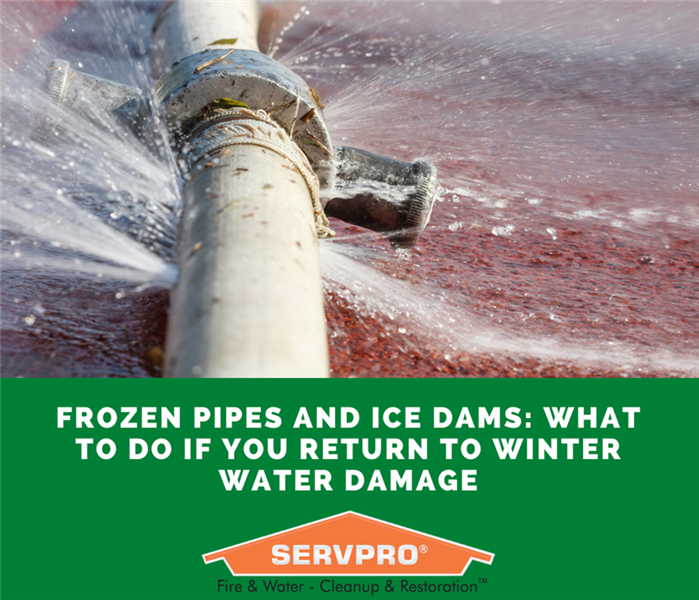Frozen Pipes and Ice Dams: What to Do If You Return to Winter Water Damage
12/10/2024 (Permalink)
 By spotting early warning signs, acting swiftly, and taking preventive measures, you can protect your home from frozen pipes and ice dam damage.
By spotting early warning signs, acting swiftly, and taking preventive measures, you can protect your home from frozen pipes and ice dam damage.
Winter vacations are the perfect time to relax, but coming home to frozen pipes or water damage can quickly undo that peace of mind. When temperatures drop, frozen pipes and ice dams can lead to leaks, water damage, and costly repairs if not addressed promptly. Here's everything you need to know to identify, resolve, and prevent these common winter hazards.
1. Understanding the Risks: Frozen Pipes and Ice Dams
- Frozen Pipes: When temperatures plunge, water inside pipes can freeze and expand, causing cracks or bursts. Once thawed, the resulting leaks can flood your home and cause extensive damage.
- Ice Dams: Ice dams form when melting snow on your roof refreezes at the edges, creating blockages. This trapped water can seep into your home, damaging walls, ceilings, and insulation.
2. Signs of Frozen Pipes or Ice Dam Damage
Be vigilant for these warning signs:
- Water Stains: Discoloration on walls or ceilings may point to leaks from melting ice dams.
- Low Water Pressure: Weak water flow could indicate frozen pipes restricting water movement.
- Pooling Water or Damp Spots: Look for unexpected moisture near exterior walls, basements, or under sinks.
- Frost on Pipes: Pipes in unheated spaces, like basements or attics, may visibly frost over if frozen.
3. Immediate Steps to Take
If you discover water damage or suspect an issue, act quickly to minimize harm:
- Shut Off Water: Turn off your home's main water supply to halt leaks from a burst pipe.
- Turn Off Power: For flooded areas, cut electricity to avoid dangerous water-electricity interactions.
- Drain Pipes: Open all faucets to release trapped water and reduce pipe pressure.
- Remove Standing Water: Use towels or a wet-dry vacuum to mop up water, especially on carpets or wood floors, to prevent mold growth.
4. Thawing Frozen Pipes Safely
For frozen but intact pipes, follow these steps:
- Apply Heat Gradually: Use a hair dryer, space heater, or heating pad to warm pipes slowly. Avoid open flames or intense heat, which can damage pipes.
- Start with Accessible Pipes: Begin with exposed pipes, then address harder-to-reach areas.
- Keep Faucets Open: A trickle of running water helps thaw pipes faster and relieves pressure.
5. Handling Ice Dam Damage
If an ice dam has caused water to infiltrate your home, take these steps:
- Inspect Insulation: Remove and replace any wet attic insulation to prevent mold growth.
- Check Walls and Ceilings: Repair damp or discolored areas quickly to avoid further damage.
- Dehumidify: Use a dehumidifier to dry out remaining moisture from walls and ceilings.
6. When to Call Professionals
Certain situations require expert help, including:
- Significant flooding or water damage.
- Mold growth on affected surfaces.
- Water infiltration into electrical systems or insulation.
Professional water restoration teams, like SERVPRO of Newton / Wellesley, use advanced tools such as industrial fans, dehumidifiers, and moisture meters to ensure a thorough cleanup.
7. Preventing Future Issues
Take these preventive measures to safeguard your home:
- Insulate Pipes: Wrap exposed pipes with foam or insulation tape.
- Leave Faucets Dripping: A small trickle of water helps prevent freezing during extreme cold.
- Enhance Attic Insulation: Proper insulation slows roof snowmelt, reducing ice dam risks.
- Clear Gutters: Remove debris from gutters to allow melting snow to drain freely.
8. Pre-Travel Precautions
Before leaving for a winter getaway, prepare your home:
- Set Your Thermostat: Keep it at least 55°F to prevent freezing.
- Shut Off Water Supply: If feasible, turn off the main water line and drain pipes.
- Open Cabinets: Allow warm air to circulate around pipes under sinks.
Winter vacations should leave you feeling refreshed, not stressed. By spotting early warning signs, acting swiftly, and taking preventive measures, you can protect your home from frozen pipes and ice dam damage.
SERVPRO of Newton / Wellesley has advanced training and equipment to restore your home or business, giving you peace of mind during winter and beyond.






 24/7 Emergency Service
24/7 Emergency Service